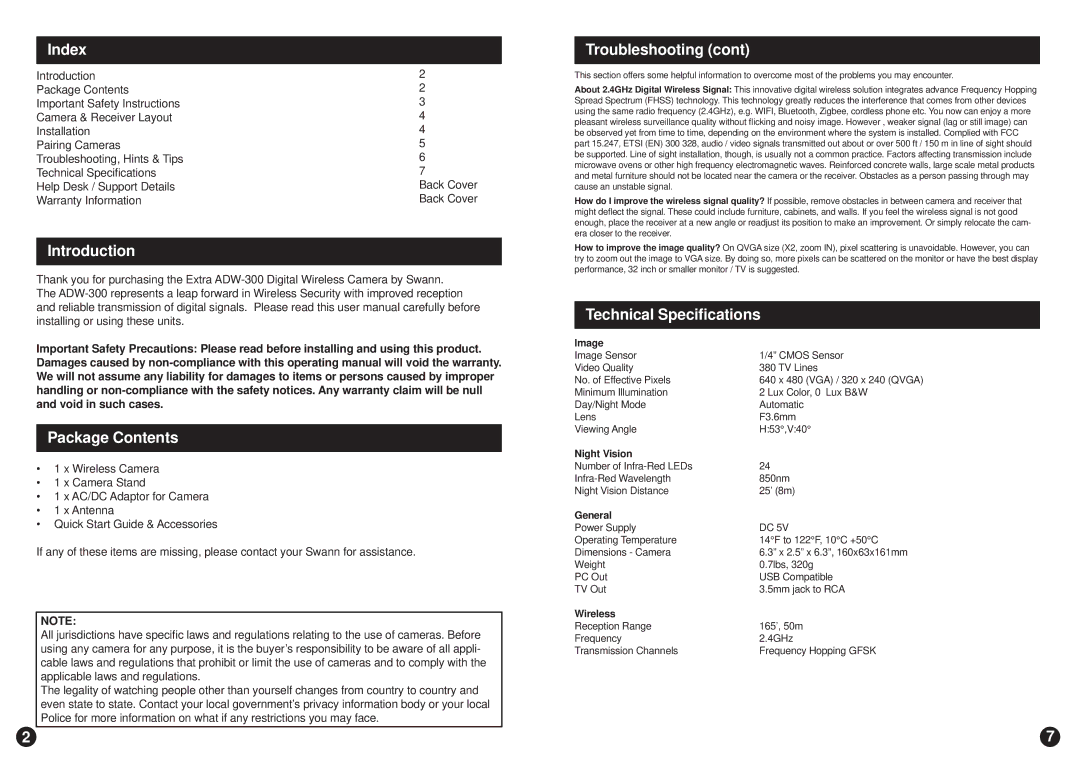
Index
Introduction | 2 |
Package Contents | 2 |
Important Safety Instructions | 3 |
Camera & Receiver Layout | 4 |
Installation | 4 |
Pairing Cameras | 5 |
Troubleshooting, Hints & Tips | 6 |
Technical Specifications | 7 |
Help Desk / Support Details | Back Cover |
Warranty Information | Back Cover |
Introduction
Thank you for purchasing the Extra
Important Safety Precautions: Please read before installing and using this product. Damages caused by
Package Contents
•1 x Wireless Camera
•1 x Camera Stand
•1 x AC/DC Adaptor for Camera
•1 x Antenna
•Quick Start Guide & Accessories
If any of these items are missing, please contact your Swann for assistance.
NOTE:
All jurisdictions have specific laws and regulations relating to the use of cameras. Before using any camera for any purpose, it is the buyer’s responsibility to be aware of all appli- cable laws and regulations that prohibit or limit the use of cameras and to comply with the applicable laws and regulations.
The legality of watching people other than yourself changes from country to country and even state to state. Contact your local government’s privacy information body or your local Police for more information on what if any restrictions you may face.
Troubleshooting (cont)
This section offers some helpful information to overcome most of the problems you may encounter.
About 2.4GHz Digital Wireless Signal: This innovative digital wireless solution integrates advance Frequency Hopping Spread Spectrum (FHSS) technology. This technology greatly reduces the interference that comes from other devices using the same radio frequency (2.4GHz), e.g. WIFI, Bluetooth, Zigbee, cordless phone etc. You now can enjoy a more pleasant wireless surveillance quality without flicking and noisy image. However , weaker signal (lag or still image) can be observed yet from time to time, depending on the environment where the system is installed. Complied with FCC part 15.247, ETSI (EN) 300 328, audio / video signals transmitted out about or over 500 ft / 150 m in line of sight should be supported. Line of sight installation, though, is usually not a common practice. Factors affecting transmission include microwave ovens or other high frequency electromagnetic waves. Reinforced concrete walls, large scale metal products and metal furniture should not be located near the camera or the receiver. Obstacles as a person passing through may cause an unstable signal.
How do I improve the wireless signal quality? If possible, remove obstacles in between camera and receiver that might deflect the signal. These could include furniture, cabinets, and walls. If you feel the wireless signal is not good enough, place the receiver at a new angle or readjust its position to make an improvement. Or simply relocate the cam- era closer to the receiver.
How to improve the image quality? On QVGA size (X2, zoom IN), pixel scattering is unavoidable. However, you can try to zoom out the image to VGA size. By doing so, more pixels can be scattered on the monitor or have the best display performance, 32 inch or smaller monitor / TV is suggested.
Technical Specifications
Image |
|
Image Sensor | 1/4” CMOS Sensor |
Video Quality | 380 TV Lines |
No. of Effective Pixels | 640 x 480 (VGA) / 320 x 240 (QVGA) |
Minimum Illumination | 2 Lux Color, 0 Lux B&W |
Day/Night Mode | Automatic |
Lens | F3.6mm |
Viewing Angle | H:53°,V:40° |
Night Vision |
|
Number of | 24 |
850nm | |
Night Vision Distance | 25’ (8m) |
General |
|
Power Supply | DC 5V |
Operating Temperature | 14°F to 122°F, 10°C +50°C |
Dimensions - Camera | 6.3” x 2.5” x 6.3”, 160x63x161mm |
Weight | 0.7lbs, 320g |
PC Out | USB Compatible |
TV Out | 3.5mm jack to RCA |
Wireless |
|
Reception Range | 165’, 50m |
Frequency | 2.4GHz |
Transmission Channels | Frequency Hopping GFSK |
2 | 7 |
